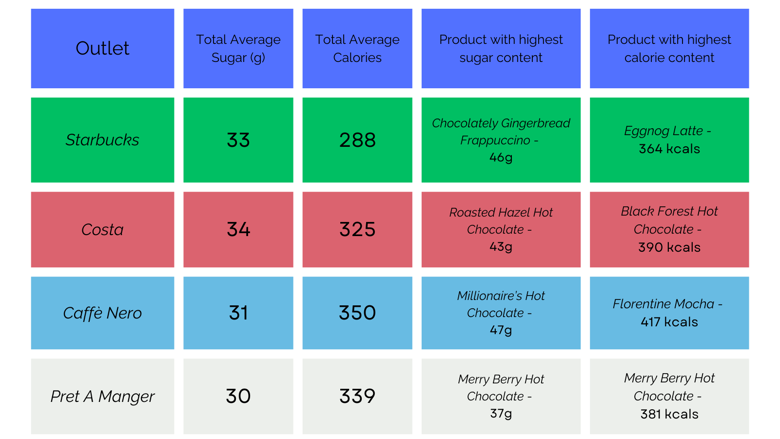Festive menus 2023 – The tip of the sugar iceberg
14 December 2023
The small print
To find a popular example of this, look no further than the festive specials on offer in the biggest coffee chains across the country during November and December. The nutritional information for some items, such as special hot chocolates and cakes, can be quite alarming. We carried out a small survey of four large UK coffee companies to reveal calorie and sugar contents of their 2023 seasonal drink specials (Table 1). Below are some of the most shocking findings (based on medium/regular serving sizes with semi-skimmed milk):
- The Chocolately Gingerbread Frappuccino from Starbucks has a sugar content of 46 grams (50% more sugar in one product than dietary guidelines recommend for a full day).
- Café Nero’s Florentine Mocha offers over 400 kcals – just under a quarter of a woman’s recommended daily intake in a single drink.
- Of the 29 drink products surveyed, only 10 had a sugar content lower than 30 grams.
- The average sugar content for all items on Costa’s festive drinks menu is 34 grams.
Of course, it is natural for people to use the festivities as a time to celebrate and treat one another, however there is no denying that this level of excess, potentially experienced regularly throughout the season, is a real threat to people’s health. And importantly, despite calorie information often being available at point of sale for products such as these, sugar contents are not. This leaves customers in the dark regarding just how much these drinks are pushing health boundaries.

Average total sugar and calorie contents of 2023 festive drinks menus (based on medium/regular sizes using semi-skimmed milk)
The wider issue
This trend of unhealthy boundary-pushing in coffee chains relates strongly to similar findings published by Action on Sugar in November 2023. Their own survey of UK coffee chains found ‘over a third of drinks and sweet products sold in major high street coffee shops exceed an adult’s daily limit of sugar per serve’ – underlining this as a problem extending beyond just festive specials.
Our survey findings, along with those from the wider sector, confirm that efforts to improve nutritional quality in the out of home sector have fallen completely short. Arguably the biggest indicator of this failure were the results of Public Health England’s Sugar Reduction Programme published this time last year. The programme, put forward as a voluntary public health intervention for businesses, challenged all corners of the food sector to reduce the quantities of sugar in their products by 20% by 2020. But the final progress report showed that the out of home sector achieved a miniscule 0.2% reduction in average sugar servings per 100g between 2017 and 2020. Some specific categories did show improvements in sugar reduction, such as cakes and morning goods, however overall, the programme did not come close to achieving its fundamental goal.
The (clear and necessary) next steps
It’s vital we remind ourselves that the current situation is not normal, not fair, and not reasonable. It’s not normal for us to consume more sugar in 20 minutes than is healthy for an entire day. It’s not fair that people are left unaware of the shocking nutritional values when deciding what to order in a shop (unless they go out of their way to find it). And it’s not reasonable to assume the industry will change any of this on its own due to the risk of falling behind competitors.
Fortunately, there are actions our leaders and policymakers can take if they truly want to reverse the damage that this particular area of the food environment is doing. Regulating to ensure proper adherence to a reformulation programme (including sugar reduction), mandatory provision of important nutrition information, and creation of portion size and calorie caps are just some avenues that would help make a real difference. We should be demanding more from this sector in order to create a new normal with offerings that don’t undermine the health of the public.
Our updated briefing on the out of home sector provides more details on the current situation in Scotland and how it could be improved to support healthy diets across the population.
 The Out of Home Sector - Briefing - 2023
The Out of Home Sector - Briefing - 2023
 Eating out of home
Eating out of home